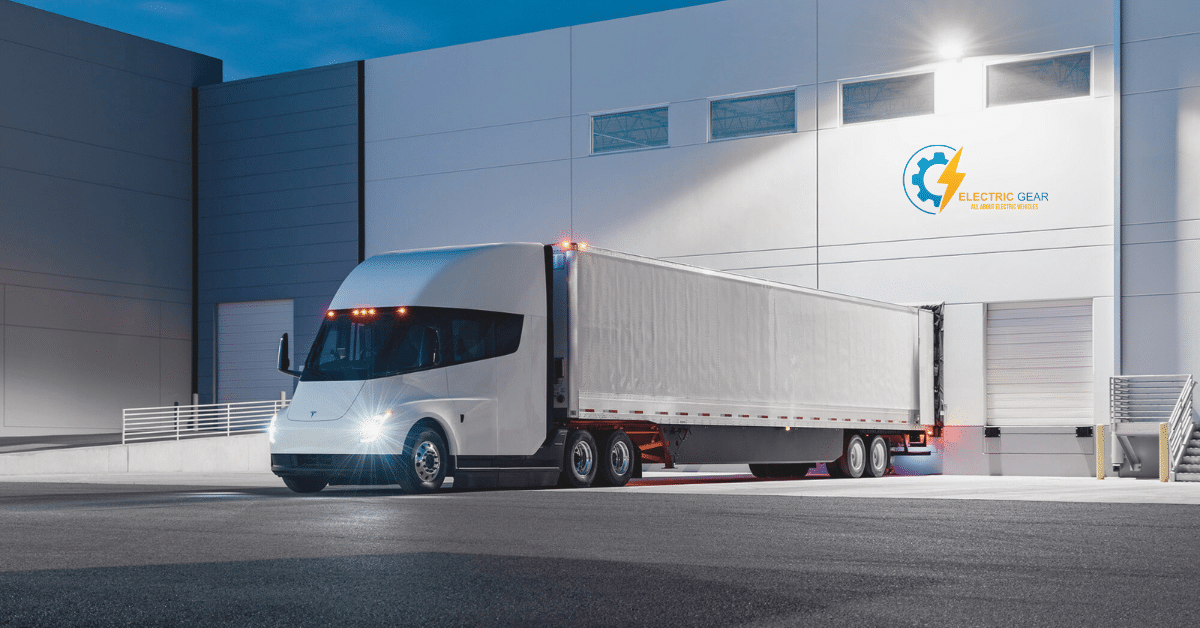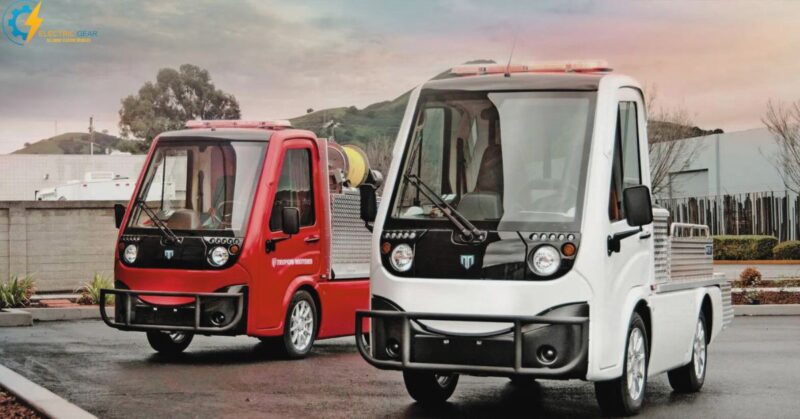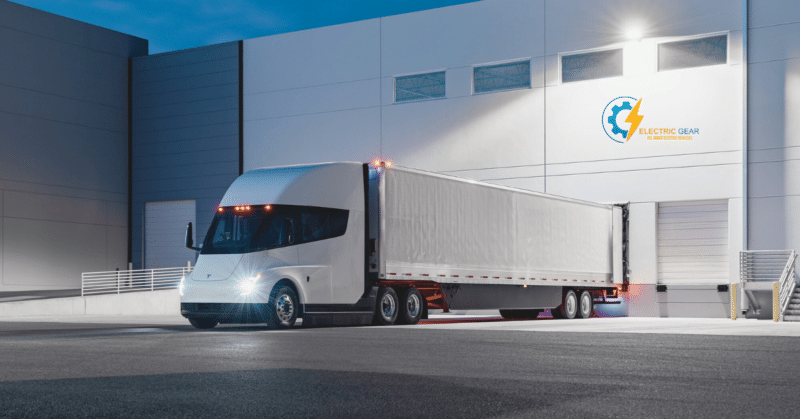In November 2017, Tesla unveiled the all-electric semi-trailer vehicle, the Tesla Semi.
Tesla Semi trucks intend to completely transform the freight business by offering a more environmentally friendly and effective mode of transportation; the Tesla Semi trucks—among other distinctive attributes —are also known for their superior performance, increased safety, and reduced operating costs.
Tesla Semi truck’s four separate motors offer unmatched acceleration and braking skills, and its 500-mile range on a single charge makes it perfect for long-distance hauling.
The Tesla Semi also stresses driver comfort and safety with a roomy cockpit, an aerodynamic design, and automation capabilities.
With the Tesla Semi, Tesla hopes to hasten the world’s switch to renewable energy sources and open the door to a cleaner, more productive future.
Tesla Semi Truck Customer Reviews and Testimonials
Since the Tesla Semi is unavailable for customer delivery, no evaluations or testimonials are available. However, the Tesla Semi has attracted much attention, and several businesses have already placed pre-orders for the vehicle. Pre-orders for the Tesla Semi have come in from a variety of companies, including:
While customer reviews and testimonials are not yet available for the Tesla Semi, the interest, and pre-orders from major companies suggest significant anticipation for the truck’s release.
As the Tesla Semi is delivered to customers and put into operation, we expect to see more reviews and testimonials from companies that have incorporated the truck into their fleets.

The first fully electric truck produced by Tesla Motors is a semi-truck. It was initially presented on November 16, 2017. and Tesla asserts that it will be accessible by 2020.
Due to complications, the launch date has been postponed until 2022. And lastly, Tesla CEO Elon Musk has tweeted once again that the company would begin semi-production at the end of 2022.
The next Tesla Semi Truck will feature a large, long-range battery pack, quick acceleration, and payload. Tesla claims it can accelerate from 0 to 60 mph in about 20 seconds with fully laden cargo.
He further said that during the vehicle’s three years of ownership, fuel costs would be saved by almost $200,000.
Here’s a table summarizing the essential information about Tesla Semi electric trucks:
| Feature | Tesla Semi |
| Range | Up to 500 miles |
| Charging time | 30 minutes for an 80% charge |
| Drivetrain | All-electric |
| Power output | 1,000 horsepower |
| Torque | 2,000 lb-ft |
| Max towing capacity | 80,000 pounds |
| Acceleration (0-60 mph) | 20 seconds |
| Top speed | 65 mph (governed) |
| Price | Starting at $150,000 |
| Pros | Zero emissions, lower operating costs, less maintenance, aerodynamic design |
| Cons | Higher upfront cost, limited charging infrastructure, shorter range compared to diesel trucks |
Overall, Tesla Semi trucks offer impressive performance and significant advantages over diesel trucks regarding environmental impact, operating costs, and maintenance.
However, the higher upfront cost and limited charging infrastructure may present challenges for some companies adopting electric trucks.
Design, Performance, and Sustainability
The Tesla Semi is an all-electric, battery-powered commercial truck first unveiled in 2017 by CEO Elon Musk. The vehicle is designed to provide a sustainable and efficient transportation solution for the freight industry.
Here’s a breakdown of the Tesla Semi’s design, performance, and sustainability:
Design: The aerodynamic form and low profile of the Tesla Semi truck’s design aid in decreasing wind drag and increasing fuel economy.

The car has a four-motor electric powertrain on two rear axles that offer a lot of torque and power. The Tesla Semi’s cab is made to fit two people comfortably and has plenty of room for cargo storage.
Performance: The Tesla Semi offers impressive performance capabilities traveling up to 500 miles on a single charge, even when fully loaded with cargo. It accelerates from 0 to 60 miles per hour in just 20 seconds when fully loaded, much faster than traditional diesel trucks.
Additionally, the Tesla Semi has a regenerative braking system that recovers energy during braking, which helps to extend the vehicle’s range.
Sustainability: The Tesla Semi aims to be a more environmentally friendly option in the trucking business. This car’s zero-emissions, all-electric drivetrain is a boon to the fight against pollution and global warming.
Tesla Semi Truck Weight
The Tesla Semi weighs roughly 27,000 pounds, with tires and other components, which puts its overall mileage at about 30,000.
The Technology Behind Tesla’s Electric Semi Tesla Trucks
Electric motors and lithium-ion batteries power Tesla’s electric semi-trucks. Here we look at the key features of the technology behind Tesla’s electric semi-trucks:
- Electric motors: The Tesla semi-truck is powered by four electric motors, one for each wheel. These motors are exceptionally efficient and may produce up to one thousand horsepower.
- Battery pack: The electric motors in the Tesla Semi are powered by a massive battery pack. You can drive up to 500 miles on a single charge thanks to the battery pack’s capacity of up to 500 kilowatt-hours (kWh).
- Charging system: The Mega charger is Tesla’s exclusive fast charging system, adding up to 400 miles of range in just 30 minutes. The Mega charger can be put at truck stops and other areas with high-powered connectors.
- Autopilot: Features including autonomous emergency braking, adaptive cruise control, and lane departure warning from Tesla’s Autopilot system are included on the Tesla Semi. Safer roads and less tired drivers are possible thanks to the Autopilot system.
- Aerodynamic design: The Tesla Semi experiences less wind resistance and uses less fuel because of its aerodynamic shape. The truck’s low center of gravity and distinctive profile reduced drag.
Cost Savings of Switching to Tesla Semi Trucks for Fleet Operators
Switching to Tesla Semi trucks can provide significant cost savings for fleet operators. Here are some of the ways that Tesla Semi trucks can help reduce costs:
- Fuel savings: The Tesla Semi trucks do not require diesel or gasoline fuel, which can significantly save fuel costs. Tesla claims the Semi can save $200,000 or more on fuel costs over its lifetime.
- Maintenance savings: Electric drivetrains often have lower repair and maintenance costs than conventional diesel engines. In addition to saving money on repairs, the regenerative braking system extends the life of the brake pads.
- Tax incentives: The cost of the Tesla Semi can be reduced by considering the tax credits and rebates offered by many states and local governments to enterprises that invest in electric cars.
- Reduced downtime: The Tesla Semi travels up to 500 miles on a single charge, reducing downtime spending during refueling or recharging. The truck also has a low center of gravity and advanced safety features, which can reduce accidents and downtime due to repairs.
- Improved efficiency: The aerodynamic shape and regenerative braking technology of the Tesla Semi can increase productivity while decreasing energy loss. This has the potential to lessen our energy use and hence our influence on the environment.
The Future of Trucking: Tesla’s Semi Trucks Take the Lead
Tesla’s Semi trucks are the forerunner of the electric transportation industry. Tesla’s Semi trucks are a more environmentally friendly, efficient, and affordable option for the shipping sector because of their cutting-edge all-electric motor, innovative safety measures, and stylish design.
Trucking firms and the environment benefit from the conversion to electric vehicles since they save operating costs and increase air quality.
Tesla Semi trucks are leading the electric revolution and paving the path for a more environmentally friendly future in transportation as the globe moves toward a more sustainable future.
Electric Power Meets Big Rigs
The Tesla Semi Trucks are a game-changer for the freight industry, providing a sustainable and efficient transportation solution. Here’s a closer look at the electric power behind this big rig:
Powertrain: The Tesla Semi Truck features an all-electric powertrain with four electric motors to provide exceedingly high power and torque. This innovative design allows the vehicle to accelerate quickly, even when fully loaded with cargo.
The electric powertrain also produces zero emissions, thus, making it more favorable for the environment than conventional diesel-powered vehicles.

Battery: The Tesla Semi’s enormous Battery pack provides a range of up to 500 miles with a single battery charge. The battery is installed under the car, which improves handling by reducing the vehicle’s center of gravity.
The battery pack is also made to be replaced fast, meaning that the Tesla Semi Truck can switch out a dead battery for a fully charged one without waiting hours.
Autopilot: Tesla’s Autopilot system is only one of several high-tech safety and comfort features incorporated in the Tesla Semi Trucks. Cameras, radar, and ultrasonic sensors work together to monitor the area around the vehicle and trigger appropriate actions.
The Autopilot system has the potential to enhance driving safety, decrease the occurrence of road accidents, and boost fuel economy.
Design: The Tesla semi-truck boasts an aerodynamic and contemporary appearance. Despite its modest appearance, the vehicle’s cab is roomy enough to accommodate two adults and has lots of storage space.
The Tesla semi-trucks advanced suspension and braking technology make it very flexible and stop quickly and safely in an emergency.
Tesla Semi-Electric Truck Towing Capacity
The Tesla Semi electric truck has a maximum towing capacity of 80,000 pounds. It is the maximum weight allowed on US highways without a special permit.
The Tesla Semi’s impressive torque, power output, and all-electric drivetrain make it a strong competitor to diesel-powered trucks in towing capacity.
Tesla Semi Truck Safety Features and Regulations
In addition to including various cutting-edge safety elements in the Semi truck’s design, Tesla has been striving to ensure that the Semi complies with all applicable safety laws. The following are some of the major safety standards and laws that apply to the Tesla Semi:
Tesla Semi Truck Interior
The driver’s convenience, safety, and comfort were prioritized while designing the inside of the Tesla Semi truck. The driver’s seat sits in the middle of the cabin and has plenty of headroom and legroom.
The interior is roomy and ergonomically constructed. The driver’s seat is also adjustable for ultimate comfort on extended journeys.
Like the ones featured in Tesla’s passenger cars, the Tesla Semi’s steering wheel has a touchscreen display and many control buttons.
A more user-friendly and effortless driving experience is made possible by the truck’s Autopilot features that are also included in the steering wheel.
The cabin of the Tesla Semi also has a large touchscreen display that manages several amenities, including navigation, entertainment, and temperature control. The dashboard mounts the display, making it accessible to the driver.
The cabin of the Tesla Semi also has a music system, a refrigerator, and enough storage space for luggage and equipment. Overall, the inside of the Tesla Semi is designed to provide drivers with a relaxing and secure working space that increases efficiency and reduces tiredness.
Tesla Semi Truck Price
On Tesla’s website, the introductory pricing for the 300-mile and 500-mile versions of the Tesla Semi truck is stated as $150,000 and $180,000, respectively. These costs, however, are tentative and do not account for extra choices, taxes, or delivery fees.
It’s vital to remember that the Tesla Semi costs more than the typical cost of a conventional semi-truck driven by diesel.
Tesla contends that the truck’s all-electric drivetrain, reduced maintenance requirements, and decreased gasoline prices result in a much cheaper overall cost of ownership over time. Additionally, Tesla offers a four-year, 500,000-mile guarantee for the Tesla Semi, giving fleet owners extra piece of mind.
Due to its potential for cheaper running expenses and its environmentally friendly design, the Tesla Semi has garnered attention from several businesses despite its higher initial cost.
Tesla Semi Truck Battery Specs
Using a Tesla Megacharger, the truck can add up to 400 miles of range in about 30 minutes. With a standard 250 kW DC Fast Charger, the truck can add up to 400 miles of range in about 1.5 hours.
The charge time may vary depending on the battery’s state of charge and other factors such as temperature and charging infrastructure.
So, the battery capacity of the 500-mile Semi is anticipated to be between 850 and 900 kilowatt-hours (kWh)— based on energy usage figures.
Tesla’s Plans for Expanding Their Semi Truck Lineup
Tesla has plans to expand its semi-truck lineup in the coming years. Here are some of the latest developments and plans that Tesla has announced:
- Production and delivery timeline: Production of the Tesla Semi was supposed to commence in 2019 after its announcement in 2017. However, because of production delays, the first deliveries of the Tesla Semi are not expected until 2022 at the earliest.
- Additional models: In addition to the standard Tesla Semi with a range of 500 miles, Tesla has also announced plans to release a version ranging from 300 miles. This model is intended for shorter hauls and can help make electric trucks more accessible to a wider range of businesses.
- Battery technology improvements: Tesla is continually improving its battery technology, which will likely be incorporated into future versions of the Tesla Semi. Improved battery technology can help increase range and reduce charging times, making electric trucks even more practical for logistics companies.
- Autonomous driving capabilities: Since long ago, Tesla has been working on creating autonomous driving technology. The company recently revealed intentions to use this technology in the Tesla Semi. For logistics organizations, this may increase safety, effectiveness, and production.
- Expanding production capacity: In Austin, Texas, Tesla is setting up a new facility to cater to the demand for the Tesla Semi. This plant is planned to have a manufacturing capacity of up to 500,000 vehicles annually, which will be utilized to manufacture the Tesla Semi and other vehicles.
Conclusion
The Tesla Semi’s cutting-edge features and performance capabilities have the potential to revolutionize the transportation sector. The Semi is an effective replacement for conventional diesel trucks with a range of up to 500 miles per charge and a 0 to 60 mph acceleration time of only five seconds.
Additionally, the Semi’s safety features, such as improved autopilot and autonomous emergency braking, may greatly lower the danger of traffic accidents.
The company’s ability to reach production goals and deal with any issues that may develop throughout the rollout process will determine if the Tesla Semi is a success.
Frequently Asked Questions
What is the Tesla Semi?
The all-electric semi-trailer vehicle known as the Tesla Semi was created and manufactured by Tesla Inc. It is intended to provide long-range, high-performance cargo and freight hauling capabilities while also offering cutting-edge safety measures.
What is the range of Tesla Semi?
Tesla claims that the Semi has a range of up to 500 miles on a single charge. However, this can vary depending on factors such as the load, driving conditions, and terrain.
How long does it take to charge a Tesla Semi?
The charging time for the Tesla Semi depends on the charging method used. Tesla offers two charging options: Mega charger and Supercharger. The mega charger can charge the Semi up to 80% in 30 minutes, while the Supercharger can provide up to 400 miles of range in one hour of charging.
When will Tesla Semi be available?
The most recent expected delivery date for Tesla Semi is 2022, after many delays in manufacturing. However, depending on some variables including manufacturing difficulties and supply chain problems, this might alter.
How much does Tesla Semi cost?
The price of the Tesla Semi has not been officially announced. However, reports suggest that the base price could be around $150,000, with higher-end models costing up to $200,000 or more depending on the configuration and options selected.

Imran is an experienced content writer who crafts engaging and informative articles for a variety of industries. With a keen eye for detail and a passion for storytelling, Imran delivers high-quality content that resonates with readers. Whether he’s writing blog posts, social media content, or website copy, Imran is committed to delivering compelling content that drives results.







